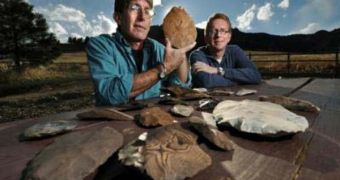Recent digs done in Boulder, Colorado, have revealed a series of stone artifacts dating back almost 13,000 years ago, which were apparently used to butcher camels and horses, two of the several hundred species of mammals that went extinct in the Americas until the end of the Pleistocene period, some 10,000 years ago. Chemical analysis has identified camel and horse protein residues on the primitive tools, researchers from the University of Colorado at Boulder report.
In the past, other discovered sets of tools tested positive for bear and sheep protein residues, hinting at the diet of the Clovis civilization, a culture that lived around 11,500 years ago (according to carbon testing), in what is now North America. Its reign over the land ended with the Ice Age, which was most likely the cause of its disappearance, although researchers still debate that issue very vividly.
The extinction that occurred in the late Pleistocene in North America is also not fully explained. Accounts range from comet impacts to global warming and excessive hunting, but in truth, researchers and archaeologists themselves admit, no one can say for sure what led to the demise of so many species. Data of the time are scarce, and it's sets of tools, like the one recently discovered, that can give modern-day scientists clues about the lifestyle our ancestors had more than 13,000 years ago.
“The idea that these Clovis-age tools essentially fell out of someone's yard in Boulder is astonishing. But the evidence I've seen gives me no reason to believe the cache has been disturbed since the items were placed there for storage about 13,000 years ago,” Douglas Bamforth, an Anthropology professor at the university, says.
“I was somewhat surprised to find mammal protein residues on these tools, in part because we initially suspected that the Mahaffy Cache might be ritualistic rather than a utilitarian. There are so few Clovis-age tool caches that have been discovered that we really don't know very much about them,” California State University Anthropology professor Robert Yohe, who has received all the 83 items that have been unearthed at the university's Laboratory of Archaeological Science, adds.
According to the researchers, the weapons were buried near what was once a stream, which would make sense, as far as hunting habits go. Throughout the world, civilizations bloomed near waters, and the Clovis culture wasn't at all different. Hunting parties could always resort to hidden weapons if something went wrong, which means that others might be found in the future as well.

 14 DAY TRIAL //
14 DAY TRIAL //